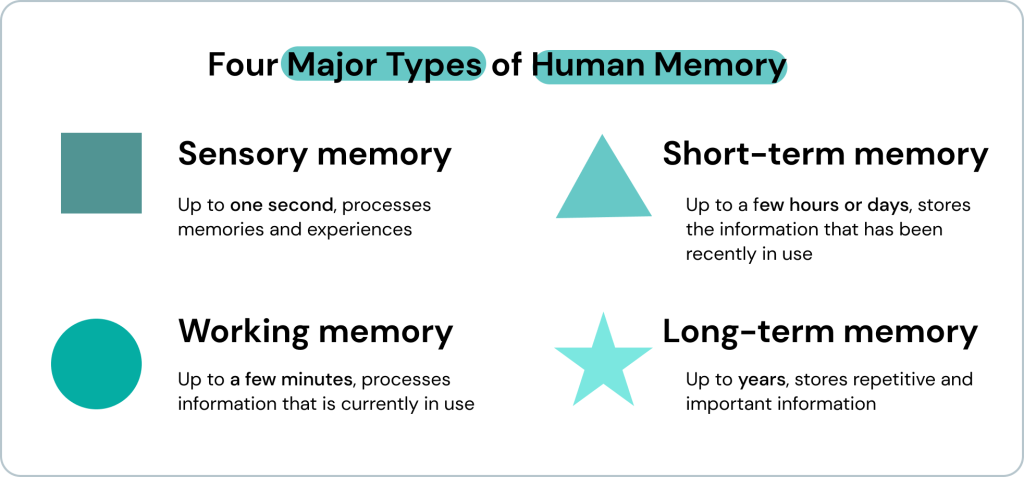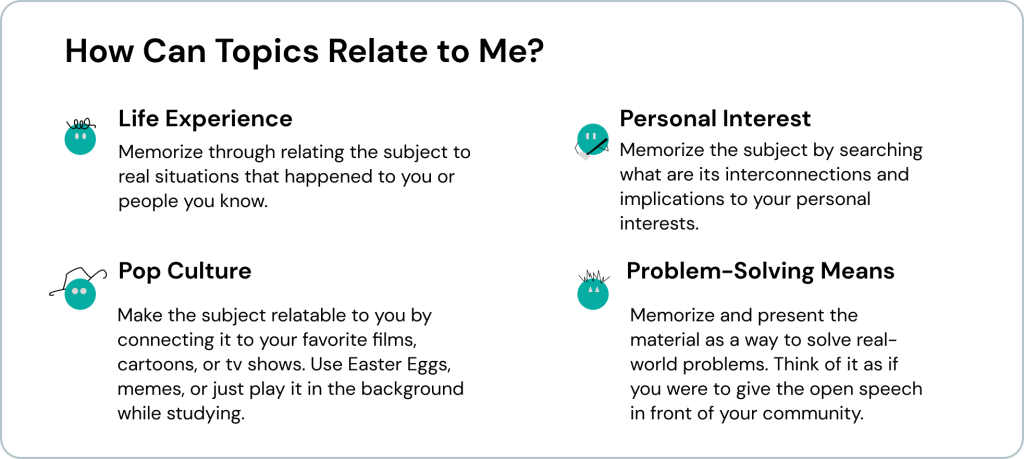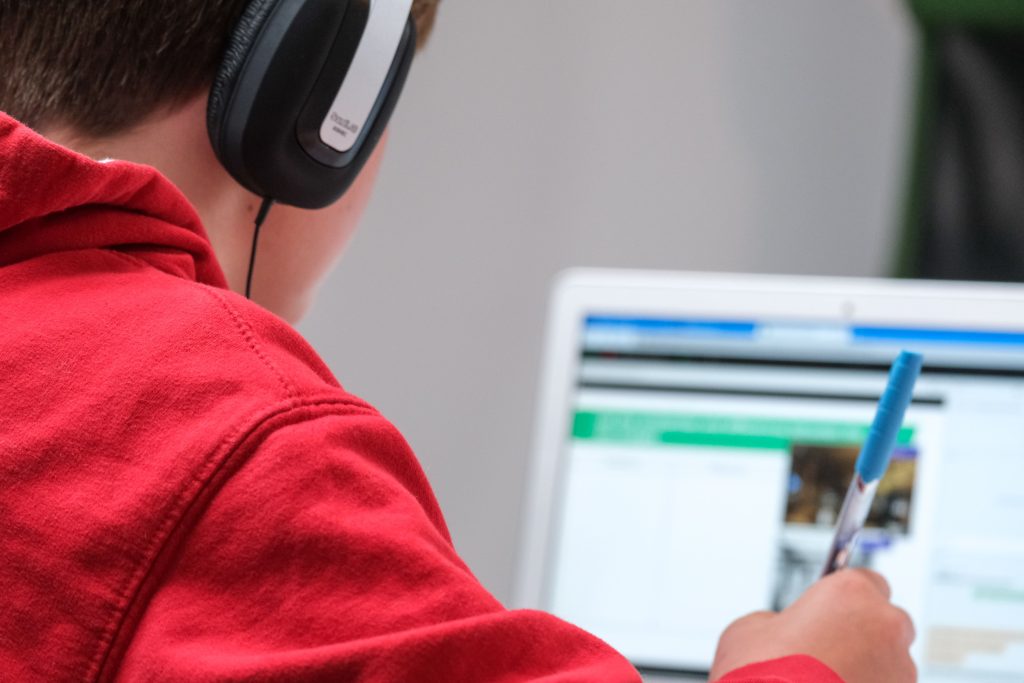In the 19th century, German psychologist Hermann Ebbinghaus came to the conclusion that the human brain loses up to 90 percent of the learned material within the first seven days after learning. These results are consistent with the recent Ebbinghaus test replication conducted in 2015. What does that mean for you, studying for your regular tests, midterms, and finals? It is no wonder you have a loose memory retention, as it’s a natural process. So it is only natural if you no longer remember popular poem structures or anything like that. But if not students, who will beat the laws of nature? We have a lot of effective memory tricks so you can do a bang-up job on your exams. The very first thing you should do to improve your memory is define and understand your memory type. It makes no sense to read random tips on memorization if you haven’t done the core work.
Further in the article:3 Basic Memorization Strategies to Start Your Test-Taking Preparation |
3 Basic Memorization Strategies to Start Your Test-Taking Preparation
The very first thing you should do to improve your memory is define and understand your memory. It makes no sense to read random tips on memory if you haven’t done the core work. Yep, it may sound boring and complicated, but we promise it is not. So, in order to improve your studying, you have to…
Use memory types to your advantage
There are four major types of human memory: sensory, working, short-term memory, and long-term memory. You can use this division for different situations where you need to memorize something. Here are some examples of how you can allocate your memorizing efforts more efficiently:
- Sensory memory: a brief memory that records the fact of having an interaction experience. Example: use your sensory experiences to back up the memorizing process with other types. For instance, think of the emotions the topic causes while you are trying to keep in mind the professor’s narration.
- Short-term memory: a brief memory that holds information for up to ten minutes. Example: use short-term memory if the information is not crucial. If your curriculum covers the topic out of the ACT or SAT requirements, don’t bother remembering for a long time.
- Working memory: a small volume of information your brain can hold while working on one task. Example: use it as your most valuable resource. Imagine a tank with water. This is your working memory. Do not spend the whole tank on one plant.
- Long-term memory: a memory you use to recall detailed information with no external sources. Example: use long-term memorizing for practical knowledge. Turn all theoretical information into practical, and store it in your long-term memory as ready-to-use information.

You must know these types so that you don’t blame your memory for failing you because the problem is not in your memory. It’s not about you being incapable to overcome laziness in school. The problem is in you using memory the wrong way.
Pass the information from one memory type to another
Now, we come to the practical application. So, how do you make sense of any memory technique you want to try? Any information we perceive goes through two steps: sensorial feeling and short-term memory. However, a much smaller part of perceived information ends up in the working or long-term memory. Here is how to study effectively using the four-step memory ladder:
- Register the feeling you got after interacting with the material. Make your studying process and emotions conscious so you can use them to your advantage. For instance, if that is a negative emotion, “I don’t want to study it,” make a note to register the positive “I did it!” feeling afterward.
- Anchor the information while it is in your short-term memory. To “anchor” the information means telling your brain that this knowledge is not a random casual piece of information but an important one. Typically, the data can be important for your brain if it somehow benefits your survival, well-being, or happiness.
- Make an effort to put the information in your working memory. Create a situation where you have to recall the information within 24 hours of learning. For example, casually mention what you have learned when your friend asks how your day was.
- Use spaced repetitions and active recalling to move information to your long-term memory. These two are the most effective memory techniques for studying. Make the gaps between your study sessions and extend the periods between each recall. Never passively consume the information; instead, engage with it by retelling it out loud or teaching others.
“In order to develop your long-term memory, you have to repeatedly work with your short-time and working memory. Remembering something for weeks or months requires multiple sets of exercises and a solid understanding of the information.”
Nicolas Evans, an expert at CustomWritings.com
Use memorization techniques strategically
Please, open your search engine and type “best memory techniques” as the search. You will find mnemonic forms, the method of loci, the Feynman technique, or chunking, all of which are good. However, not all of them will work for you. Here is an example of how to quickly define whether the technique suits you:
You want to gain a 34-36 score on the ACT – the American College Test, and as part of it, you have to study radiation for the science part of the exam. You want to try a chunking memory technique, merging small bits of information into more sustainable components. You have a paragraph, and one peer-reviewed article to study for the class. Here are the steps you need to do for this case:
- Search for the existing chunks in the class book and article material. Do the same with whatever memory techniques you explore, as many study materials also use the same techniques to deliver the knowledge.
- Create five chunks for your book chapter and fill them with content. It’s important that you simplify testing new memory techniques as much as possible.
- Reflect on the memorization technique. Do you feel the difference between using it and not using it? Did it help to understand the material better? Does it take too much time to do the technique?
That’s it. These are the most basic principles to drastically improve your studying for exams.
Step one: know how your memory works. Step two: play ping-pong with your four memory types. Step three: use memorization techniques strategically and reflect on their efficiency.
3 Specific Memory Techniques for Studying
Okay, we have covered the basics of what to do for the most effective usage of your memory capacities. Now, let’s dive into a more detailed analysis of the memorization techniques. Essentially, they all delve into three goals:
- To make the study material relatable for you
- To make causal relations between what you know and what you learn
- To improve your motivation to memorize facts
Technique #1. Make boring topics relatable
It’s only logical that human memory stores information of exclusive importance, ignoring all other noise. The problem is that the information you learn for your finals holds no importance except for influencing your grades. You are in no danger of immediate death, starving, or becoming homeless, at least within hand’s reach. However, you can use one of the following methods to transmit the importance of information to your brain.

- Develop the story
We learn stories better than any other type of information. Hence, even if you study a technical subject, you can turn it into a fascinating plot.
Here is an example: Computer engineering students have to learn natural language processing, which helps with translation and speech recognition. This chunk of information includes the process of text preprocessing, which is a complicated procedure. Instead of learning that you must “import the libraries, tokenize the text, convert text to lowercase, remove punctuation,” and so on, write a story.
For instance, it can be a dreams essay or a story of you playing a video game, where you must conquer a kingdom. You “download” your army into the desired territory, and then you split (tokenize) the opponent’s army. However, the enemy raises the most combat-ready upper-cased warriors, so you spend some time lowering them. Sounds like more fun, doesn’t it?
- Teach someone else
By teaching someone, we significantly increase the rate of our memory retention. You can teach your younger siblings, organize a study group, or teach yourself using the mirror. For instance, a student who is a year younger than you will be happy to get a little mentoring session.
- Change your role model
Now you are a student who studies to pass an exam. You will get no salary for this, and no one else has accountability for your results. You are used to the student role, and it probably fails to provide the same motivation as before. Instead, do not perceive yourself as a passive listener, reader, or student at all. Imagine yourself as a journalist making an article, a professional having a conversation with a colleague, or a new employee in the company adjusting to your new work.
Technique #2. How to remember what you read?
To remember what you read, you must connect the new concepts to existing ones. Your memory is a network of neurons, and new ones cannot randomly form somewhere. They are only formed as an extension of the existing mesh. So, each new bit of information must connect to the information you already know. Here is how that applies in practice.
- The task
The math part of the Scholastic Aptitude Test usually integrates some questions on data analysis. For instance, here is the typical question you may receive. “In a survey of 100 students, 40 had a dog, 30 had a cat, and 15 had both. How many students had neither a dog nor a cat?”
To get the correct answer, you have to memorize the concepts of the set theory (union, intersection, set difference) and choose the most applicable part of it. While the mathematical explanations are quite complicated, you can use your daily experience and general logic to manage intersection equations.
“To remember what you read, you must connect the new concepts to the existing ones. Our professor taught us that when we studied economics and finances. These are tough subjects, so he told us a lot about memorization techniques. This one worked the best.”
Akari Saito, a marketing student in New York
- Simplifying the task and relating the new information to existing knowledge
Think about the task practically, starting with something you know. In the question, we know how many people have EITHER a cat, a dog, or both. This leaves us with an interlay of people with only one pet and people with both. So, we need to remove this obstacle first.
- Resolving the problem
- Subtract the # of students with both from the total # of students with dogs = Students with a dog only (40-15 = 25)
- Subtract the # of students with both from the total # of students with cats = Students with a cat only (30-15 =15)
- Total number of students – (Students with a dog only + Students with a cat only + Students with both) = Students with neither (100-25-15-15 = 45)
In this example, you don’t need mathematical formulas or definitions of the set theory and intersection equations. You only need to remember that set theory “intersection questions” are about reducing the intersection in the numbers – that’s all. You already know from daily experience what the intersection is and how to count, so all you must do is connect the new note to that knowledge.
Technique #3. Make memorizing pleasurable
Students often quit studying because the process is complicated, long, and unenjoyable. As we live in the digital era, our cognitive function gets exposed to constant informational flow and thus becomes resistant to the new incoming data. Your memory is constantly overloaded and stressed, so you need a multi-step “decluttering process” to refresh it. Here are a few steps you can start with:
- “Clean” your working memory
The first part of memory to suffer from informational overload is your working memory. This part is connected to your concentration. For instance, if you have just scrolled TikTok for about half an hour, your working memory processed about 60 videos (each one half a minute long). That means that for each video, your working memory had to
a) Visually receive the information
b) Comprehend its meaning
c) Evaluate whether it’s important
d) Pass it to your short-term memory
e) Start the process with a new video just a few seconds later
No wonder the memorizing process is not pleasurable for you. In the same way, you would not enjoy the 60th piece of cake, even the one with your favorite flavor. Reduce the informational exposure to your brain, and you will notice how memorizing becomes easier.
An experimental study reported that participants who scrolled Facebook for 20 minutes had much lower mood levels than those who browsed the internet and poorer memory recall. The possible reason for that is the high speed of users switching between posts compared to those who consume fully-fledged information.
- Provide yourself with fast rewards
Here is one more theory from the neuroscience world: our cognitive capacities have two energy (motivation) sources. These are getting a reward for positive behavior and getting punishment for negative. While you probably have enough threat of psychological punishment in case you fail the finals, you can add a reward for each positive step toward the goal.
You must be proud of yourself for finishing a task and reward yourself either psychologically or materially. For instance, here are some small rewards that require no special resources from you:
Take five minutes for positive self-talk. Imagine you are sharing your little success with your friends. Tell yourself what was hard about the material you memorized and how you feel for actually doing it.
“As an international student in a new country, I had awful cropping anxiety most of the time. Positive self-talk as an intentional practice actually helped me with studying. My experience using it was unrelated to memory, but it works well for any reason you start practicing it.”
Xiu Zhang, an international student in the USA
Cross the point off your to-do list. There are only a few things equal to the joy of finishing tasks, crossing off the corresponding points, and feeling free.
Social media time. If you have memorized everything and called it a day, you can allow yourself time on social media guilt-free. Most of us these days consider this activity a guilty pleasure and are ashamed of it. However, completing a task is a good chance to improve your memorization skills and develop a healthy screen habit. (The topics on social media impact research confirm that!)

- Use the locus of control
The concept of locus of control claims that the more you feel that life happens with you, not to you, the more actively you participate in your life. This rule applies to your memory, too. If you believe that you have a memory like a sieve, you are more likely to act accordingly. Instead, if you believe that your memory can be trained and developed, you will practice to improve.
No matter whether you run for the highest paying engineering jobs or aim at getting scholarships for low income students, training your memory is a go-to strategy in every case. We hope that these simple methods will help you prepare for the challenges you will face. Let your memory be uncompromisable, and we will cross our fingers for your luck!





